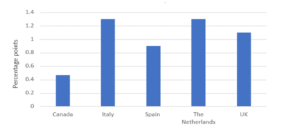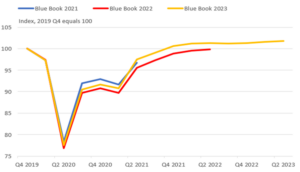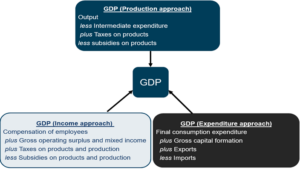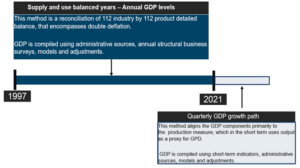Background
50. The revisions that ONS announced on 1 September 2023 to estimates of economic growth during the period of economic upheaval caused by the COVID-19 pandemic generated a wide discussion in the media. The main controversy was reported as ONS having changed the story of economic growth compared with the previous year’s estimates. Within this, examples of media reporting included “Britain’s statisticians fix a blunder and find a bigger economy“, and that there was an “‘Extraordinary’ upgrade for GDP”.
51. ONS was the first National Statistical Institute to estimate GDP for 2021 using the structural analysis of the Supply and Use balancing framework, which replaced and revised the earlier estimates of GDP for that year. Other countries that subsequently published GDP estimates for 2021 recorded revisions of similar magnitude compared with their earlier estimates. This reflected the challenges they encountered in measuring these early estimates during the latter part of COVID-19 when countries were beginning to lift restrictions. Figure 1 compares revisions to early estimates of GDP growth rate for 2021 for the UK with other countries, all of which experienced substantive revisions.
Figure 1: International comparison of annual revisions to real GDP growth for 2021
Sources:
- Canada: Statistics Canada: The 2019 to 2021 Revisions of the Income and Expenditure Accounts
- Italy: Istat: Annual National Accounts (Years 2020-2022) Press Release
- Spain: INE: Annual National Accounts of Spain Press Release
- The Netherlands: Statistics Netherlands: Revisions to GDP and GNI in 2021 and 2020 CBS Publication
- UK: ONS: Impact of Blue Book 2023 changes on Gross Domestic Product
52. Figure 2 shows how the volume index of real GDP has changed during the 2021, 2022 and 2023 annual national accounts production cycle, presented in subsequent Blue Books, referenced to the fourth quarter of 2019.
Figure 2: Real-time estimates of the level of volume GDP, Quarter 4 (Oct to Dec) 2019 to Quarter 2 (Apr to Jun) 2023, UK
Figure 2 compares the volume index of real GDP, referenced to the fourth quarter of 2019 equal to 100, presented in the 2021, 2022 and 2023 Blue Books.
Source: ONS GDP revisions in Blue Book: 2023 Article (Figure 3)
53. GDP is a core macro-economic indicator that measures the size of the economy and how it has grown. It is important to recognise that, in line with other countries, ONS’s estimates of GDP are statistical estimates rather than an audited number found in the financial accounts of a company. In 2021, ONS estimated the level of volume GDP for the UK to be £2.18 trillion. Estimating the level and growth of GDP poses challenges because of the size and complexity of the economy, and these challenges have been acute during more recent periods, against the backdrop of a global economy that is encountering continuous volatility. It is impossible to measure the activities of every firm or the expenditures of every household in the country. Furthermore, ONS’s estimates of GDP are not the result of a single large survey or census. They are the result of a very complex production system bringing together information from surveys, administrative sources and several adjustments and assumptions into one single aggregate.
54. The OECD’s Understanding National Accounts summarises the challenge in compiling these statistics well: “They are the result of combining a complex mix of data from many sources, many of which require adjustments to put them into a national accounts database and which are further adjusted to improve coherence, often using non-scientific methods.”
55. Given the breadth and complexity of the economy, ONS follows international guidance, which recommends the use of three main approaches to estimate GDP comprehensively:
- The production approach, which is the sum of all production activity in the UK
- The expenditure approach, which is the sum of all final expenditures (less imports) in the economy
- The income approach, which is the sum of all factor incomes in the economy. It also reflects the distribution of value added between wages and operating profits.
56. Figure 3 shows the main components used to estimate GDP by each approach. These three approaches are then reconciled to produce one coherent estimate of GDP.
Figure 3: The components used to estimate the three approaches Gross Domestic Product (GDP)
Figure 3 shows the components used to estimate the three approaches of measuring Gross Domestic Product (GDP). The components of GDP from the production approach are output less intermediate consumption plus taxes on produces less subsidies on products. The components of GDP from the income approach are compensation of employees plus gross operating surplus and mixed income plus taxes less subsidies on production. The components of GDP from the expenditure approach are final consumption expenditure plus gross capital formation plus exports less imports. The figure was created using information from the ONS’ Guide to the UK National Accounts.
57. Users need timely estimates of quarterly GDP growth to analyse and to forecast the economic performance of the country. These high-frequency estimates of GDP growth inform the OBR’sAutumn and Spring Economic and Fiscal Outlook publications, the BoE’s Monetary Policy Report, and the Chancellor of the Exchequer’s Spring Budget and the Autumn Statement.
58. However, detailed structural data needed to measure the economy on a timely basis are not available. To overcome this issue ONS uses growth indicators, mainly from output, to compile early estimates of GDP growth. As limited timely sources are available to measure the income and expenditure components, production is the main approach used to produce these early estimates of GDP.
59. To produce a comprehensive picture of economic activity, ONS gathers a large volume of in-depth information from annual sources such as structural business surveys and administrative data on wages and taxes. These data are then reconciled using a structural analysis, known as the Supply and Use framework, which through a balancing process, brings all the components together to estimate GDP at a detailed product and industry level.
60. However, the data required to complete this process are typically available only two years after the reference period and many users in the private and public sectors, including policy-makers, need more-timely estimates of quarterly data and for some users monthly GDP growth to analyse and to forecast economic activity. To meet this need, ONS uses higher frequency surveys and indicators to estimate how the economy has growth since the last period for which the full analysis has been completed. As only limited timely sources are available to measure the income and expenditure components, production is the main approach used to most up to date estimates of GDP growth.
61. As more information on income and expenditure becomes available, and then the full Supply and Use analysis is undertaken, the early GDP estimates are revised. The process used to quality assure GDP reflects these two distinct methods used to compile the estimates. Figure 4 summarises them and the years for which each method applies, using Blue Book 2023 as an example.
Figure 4: The two methods used to estimate GDP in Blue Book 2023, illustrating the data sources, the balancing process and the years to which each method applies
Figure 4 shows the two methods used to estimate GDP for Blue Book 2023, illustrating the data sources, the balancing process and the years that each method applies to. The years 1997 to 2021 are Supply and use balanced years. Annual GDP levels are derived using a method that reconciles a 112 industry by 112 product detailed balancing process that encompasses double deflation. GDP is compiled using administrative sources, annual structural business surveys, models and adjustments. The periods after 2021 are compiled using a quarterly GDP growth path. The GDP growth path uses a method that aligns the GDP components to the production measure. GDP is compiled using short-term indicators, administrative sources, models and adjustments. The figure was created using information from the the ONS’ Revisions Policy.
62. Revisions are therefore a normal part of the GDP production process and play an essential part in improving the quality of data over time. All users we spoke with recognised this and the particular challenges that ONS has faced in estimating economic activity, during the period of significant volatility caused by the COVID-19 pandemic, rising inflation (including energy prices) and geopolitical shocks. Users recognise that having access to early estimates is valuable but inevitably means revisions once data coverage increases.
Back to top



